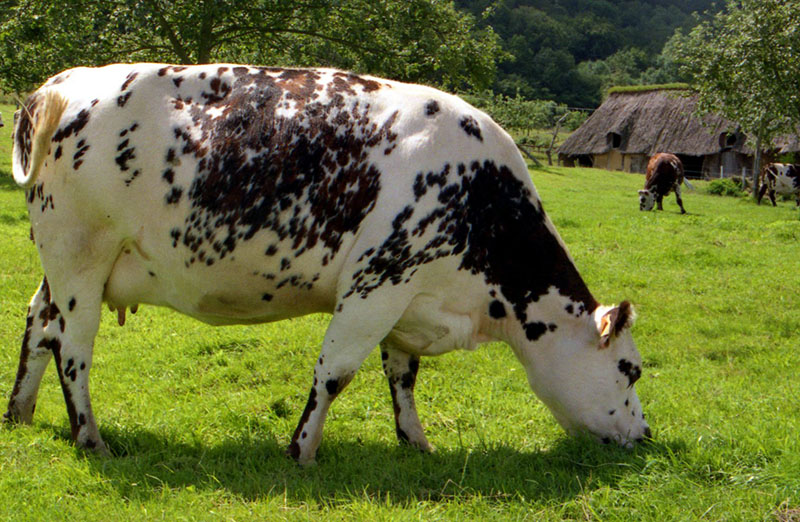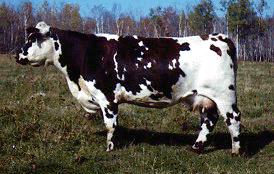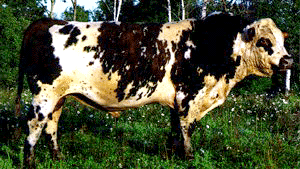Normande Cattle
The Normande breed has its origin in cattle that  were brought to Normandy by the Viking conquerors in the 9th and 10th centuries. For
over a thousand years these cattle evolved into a dual purpose breed to meet the milk
and meat needs of the residents of northwestern France. The present herd book in France
was started in 1883. Though the breed was decimated by the Allied invasion of Normandy
during World War II, there are currently 3 million Normandes in France. Their present
role in France is to provide rich milk for the cheese industry while maintaining their
excellent carcass quality.
were brought to Normandy by the Viking conquerors in the 9th and 10th centuries. For
over a thousand years these cattle evolved into a dual purpose breed to meet the milk
and meat needs of the residents of northwestern France. The present herd book in France
was started in 1883. Though the breed was decimated by the Allied invasion of Normandy
during World War II, there are currently 3 million Normandes in France. Their present
role in France is to provide rich milk for the cheese industry while maintaining their
excellent carcass quality.
Normandes have been exported world-wide but have received their greatest acceptance in South America where they were introduced in the 1890's. The cattle have thrived there as one of the world's best dual purpose breeds. Total numbers there now exceed 4 million purebreds plus countless Normande crossbreds. Columbia alone has 1.6 million purebreds with the rest mainly in Brazil, Ecuador, Paraguay and Uruguay. They are a highly adaptable and hardy breed and have done well in beef operations in the Andes Mountains at elevations up to 13,000 feet. The Normande cow with her sound feet and legs can travel great distances over rough terrain to economically convert native roughages.
Carcass Quality

Because of the breed's high muscle mass to bone ratio and their small heads, the Normande has a high percentage yield at slaughter. The carcass is very lean but marbles readily and purebred Normande steers will easily grade choice at 1,250 lbs. The Normande breed won't produce bulging rear quarters of cheap ground round but will increase the length and width of the top priced loin area cuts. In the 1990 and 1991 Montana 4-H Steer of Merit Carcass Contests, three 7/8 Normande steers placed in the top 10 out of the 1,000 steers entered annually including crossbreds. A 1991 Normande steer had a 16.2 in. rib eye, a 0.15 in. backfat, and a yield grade of 0.99! Feedlots in the U.S. and South America have proved that Normande cross steers and heifers will grade and yield with the best while maintaining moderate carcass size.
Body Type
Normandes are a medium frame size breed with most cows weighing 1,200 to 1,500 lbs. and bulls 2,000 to 2,400 lbs. They possess excellent body depth and spring of rib while maintaining exceptional body length. This characteristic high capacity body type probably explains their ability to perform on high roughage diets. The cattle are also very clean fronted and carry a strong topline. If you've lost volume and depth of body in your commercial cows, Normandes will definitely replace it.
Maternal Traits
Normande females reach sexual maturity early and have good fertility, mammary conformation, mothering ability and production longevity. They have large pelvic areas and calve easily with calves showing excellent vigor and most birth weights in the 70 to 95 lb. range. In France, milk production averages 14,000 lbs. per lactation with 4.2 % butterfat and 3.5 % protein. You won't find more productive females anywhere and half blood Normande cows are exceptional commercial beef cows when crossed with almost any beef breed.
Growth Rates
 With their rich milk, Normande purebred and crossbred cows produce calves with rapid
growth rates with no need to creep feed. Weaning weights will be in the 500 to 700
lb. range. Recent bull tests have shown that this rapid growth rate will continue
on high roughage feed. Normande bulls have topped the St. Croix Valley Bull Test at
River Falls, Wisconsin in both years that they've been entered. In 1991 a Normande
bull set an all time station record 4.93 lb. ADG and also had a 3.64 lb. WDA. The
second place bull that year was also a Normande. In the 1992 test a Normande bull
again topped the field with a 4.68 lb. ADG and a 3.49 lb. WDA. The 140 day test annually
features 100 bulls from 8 to 10 different beef breeds fed a corn silage based high
roughage ration. Studies in France have documented 5.0 feed conversion rates on the
same type of diet.
With their rich milk, Normande purebred and crossbred cows produce calves with rapid
growth rates with no need to creep feed. Weaning weights will be in the 500 to 700
lb. range. Recent bull tests have shown that this rapid growth rate will continue
on high roughage feed. Normande bulls have topped the St. Croix Valley Bull Test at
River Falls, Wisconsin in both years that they've been entered. In 1991 a Normande
bull set an all time station record 4.93 lb. ADG and also had a 3.64 lb. WDA. The
second place bull that year was also a Normande. In the 1992 test a Normande bull
again topped the field with a 4.68 lb. ADG and a 3.49 lb. WDA. The 140 day test annually
features 100 bulls from 8 to 10 different beef breeds fed a corn silage based high
roughage ration. Studies in France have documented 5.0 feed conversion rates on the
same type of diet.
